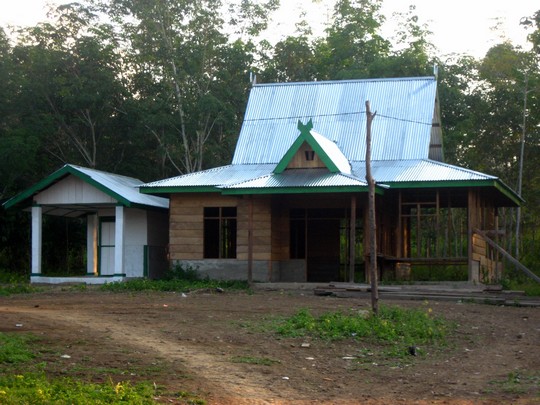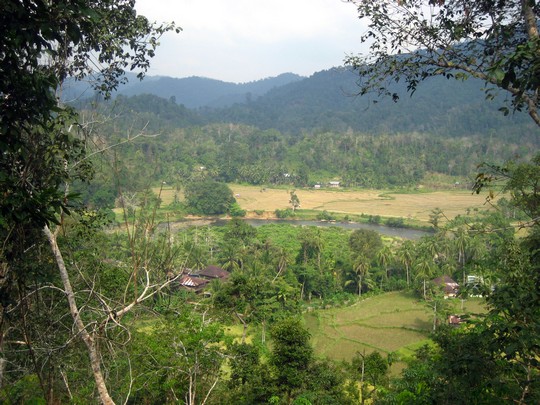Villages hope a regulation allowing them to manage forests will protect them from commercial interests
Fawziah Selamat
In Durian Rambun, a remote village of 250 people in the Sumatran province of Jambi, village chief Rosidi, 41, oversees the construction of a zinc-roofed building slated to be the main gathering point for 17 villages. Not unlike a town hall, Rosidi hopes the modest structure will be the site of ambitious discussions on transforming the region including and surrounding the 17 villages in Merangin, a forest-rich district in Jambi, into hutan desa (village forest).
This could be a big change for the people who live in these villages. The land is currently designated as production forest (hutan produksi) or limited production forest (hutan produksi terbatas) and administered by the Department of Forestry. Hutan desa, or village forest, is a form of community forestry in which villages apply for a permit to manage nearby forests. Community forestry is fast becoming an option in many forest-rich countries. The aim is to combine forest conservation with rural development in a way that promotes sustainable livelihoods, but also has minimal impact on the environment.
In Indonesia, the hutan desa idea also involves experimentation with boundary delineation as a means to guarantee land and tenure rights. Doing this is critical, because there are almost always competing claims on the forest. Indeed, competing claims from the logging and palm oil industries are the Merangin villagers’ biggest obstacles in developing their hutan desa dream. ‘Many companies want to transform the forests into oil palm plantations or logging concessions. But the benefits from those ventures don’t last long; what does last are the environmental and social damages the companies inflict on the community,’ says Rosidi.
In early 2010, Rosidi spearheaded a campaign to quash PT Duta Alam Makmur’s attempt to convert 85,000 hectares of forest within the 17 villages into an acacia (pulpwood) plantation by applying for hutan desa status for the villages. PT Duta is a subsidiary of Sinar Mas Forestry, the sole supplier of pulpwood fibre to Asia Pulp & Paper, one of the world’s largest paper companies.
Big companies wield big influence
Applying for hutan desa status essentially pits the villages against large firms. So far, only one village in Indonesia – Lubuk Beringin, also in Jambi province – has been awarded hutan desa status. Eko Waskito, the founder of Lembaga Tiga Beradik, a Jambi-based conservation group, says this is because big companies with ‘million-dollar investment plans’ wield more influence over government officials. The group has been aiding the 17 Merangin villages in securing hutan desa status since 2010.
‘The onus is on the villagers to prove their plan will provide a greater net benefit than a commercial concessionaire. The difficult part is in convincing government officials that forestry benefits should not just be measured in financial terms,’ says Waskito.
The hutan desa application process is tedious and complicated. Under the relevant forestry ministry regulation (number four of 2008), the villagers have to use their own resources to map out the exact perimeters of their forest. The boundaries are then submitted to the local district head, or bupati, who must approve them before the application can be vetted by the Department of Forestry, which has the authority to issue the hutan desa permits. The payoff, however, can be substantial.
In Indonesia, where violent and sometimes deadly conflicts often occur as a result of overlapping land claims, the hutan desa scheme forces the clear delineation of boundaries. This in turn gives residents a stake in managing their land while providing them with legal authority to ward off competing land and resource claims from companies or illegal migrants, at least for 35 years, the validity period of the hutan desa permit.
Aside from large firms, the lack of clear land rights in Merangin has attracted migrants from neighbouring provinces like Bengkulu and South Sumatra who are keen on clearing and occupying forests. ‘Like the big companies, these outsiders come to take what they can from the land, with little regard for how their actions impact upon the environment, as they can leave when things get bad. But this is our home, and we want to make sure our forests are preserved, as our livelihoods depend on them,’ says Rosidi.
Aside from setting boundaries, the villages are also required to come up with forest management plans in order to receive a hutan desa permit. These plans typically prioritise forest conservation, rather than large-scale land conversion and the creation of commercial plantations. The scheme is thus a boon for the Indonesian government if its target of 26 per cent carbon emission reductions by 2020 is meant as more than lip-service.
The plans detail how the village will conserve existing forests and rehabilitate deforested areas. The villagers are permitted to practise small-scale agroforestry, but only in areas that have already been converted to commercial use ( ie. on production or limited production forest land). Most of the 17 villages are located on such lands, but the hutan desa regulation stipulates a limit for how much they can grow and extract. Each year, a village is allowed to collect up to 50 cubic metres of wood and 20 tonnes of non-wood products such as rubber and fruits. Ideally, the Forestry Department is supposed to make annual checks to ensure the villages have stuck to the rules and made progress on their forest management plans. But the regulation also stipulates that these checks are mandatory only once every five years.
The 17 villages have already implemented part of their plans. Monthly patrol teams monitor the forests for illegal land-clearing. People who want to clear land for agricultural activities or to build houses have to get approval from the village councils, which are made up of the village chief and several elders. This requirement prevents indiscriminate expansion into the forests.
‘Many of us belong to the same marga (clan), and can trace our roots back for several generations, so adherence to adat marga (clan tradition) is strong,’ says Rahmany, 42, village chief of Lubuk Birah, one of the 17 villages awaiting hutan desa status approval. And those who go against adat are punished. Clearing land without permission, for instance, incurs a fine of two buffaloes – this would cost US$1200, a hefty sum considering the average villager earns around US$3 a day.
Forest concessions, livelihoods and the environment
The Merangin villagers claim that large-scale land conversion in their region is devastating the environment and harming their livelihoods. They remember with dread the environmental fallout when a timber concession belonging to PT Injapsin laid claim to 50,000 hectares of forest in Merangin between 1987 and 2004. Says Rahmany: ‘Rivers ran dry, fish was hard to come by and it was difficult to find timber to build our houses.’
The company received its concession during the 32-year regime of former President Suharto, a period marked by a rush to carve up Indonesia’s rich forest resources, which came under complete control of the central government. Affected villages were not consulted on timber concessions or compensated for any damages incurred. By the time Suharto fell in 1998, deforestation across the archipelago had reached a peak of 1.7 million hectares per year, according to a World Bank report.
With power devolved to the regions, Jakarta began sharing responsibilities for approving forest usage permits with district and provincial governments. Now villages, the smallest political unit in Indonesia, are seizing the opportunity to use legal channels to claim resources and territory. ‘Rural areas are usually ignored because developing remote places takes too much effort and few understand what such areas need. But who should know better about how best to develop such areas than the people living there,’ says Waskito.
To be fair, it is too early to tell whether hutan desa will result in better management of forest resources. Lack of financing may mean villagers use their own locally-produced lower-quality rubber seedlings, resulting in lower yields. They grow their seedlings from trees that have been on site for generations. It’s the same with rice. Locals concede that better seedlings and more education on agricultural practices could help them increase the yields and quality of their crops.
 |
|
A new seat of forest power? Durian Rambun's village hall, where chief Rosidi hopes to conduct discussions on transforming 17 villages in Merangin into hutan desa. / Fawziah Selamat |
Locals might also be more tempted to use slash and burn which can become destructive if used too often in an uncontrolled way. Large companies, in contrast, are usually held under greater scrutiny and are under constant pressure to improve standards and techniques.
Setting up an efficient hutan desa requires teaching villagers how best to maximise agricultural land to avoid unnecessary expansion into the remaining forest. Forest conservation also costs money. Patrollers need to be paid, adopting environmentally-friendly and sustainable practices may be more expensive, and opportunity costs in forgoing the conversion of forests into cash crops need to be compensated.
Banking on REDD+
The financial cost of the hutan desa scheme is not a big issue for Indonesia, now that it has received pledges of almost US$2 billion from countries like Norway, Australia and Germany under Reducing Emissions from Deforestation and Degradation (REDD+), an international mechanism whereby developed countries pay forest-rich countries for successful efforts in forest conservation.
Jambi is one of nine provinces in Indonesia earmarked to receive REDD+ payments, which means the Merangin district villagers can receive assistance if their hutan desa management plans result in emission reductions. REDD+ implementing agencies such as the Indonesia-Australia Forest Carbon Partnership are already looking into how the hutan desa scheme can be incorporated into REDD+.
Ratna Akiefnawati, a field manager with the International Centre for Research in Agroforestry (ICRAF), believes expectations the scheme would attract REDD+ payments helped Lubuk Beringin, Indonesia’s first hutan desa, gain its permit. ICRAF was instrumental in guiding Lubuk Beringin through the application process. ‘Hutan desa demands rural boundaries be determined and the community participate in forest conservation. This satisfies REDD+ criteria for payments, that there is a specific area that can be measured for emission reductions and you can identify the group responsible for those reductions,’ she says.
The Merangin villagers have already benefited from REDD+: PT Duta will not receive its timber concession license as this year, Indonesia imposed a two-year moratorium on permits to clear forests. The moratorium is part of Indonesia’s REDD+ deal with Norway. But illegal logging and violations in issuing forest use permits are still rampant, with ill-gotten gains totalling Rp.20 trillion each year, according to estimates from Indonesia Corruption Watch.
Forest conservationist Waskito, however, remains positive that the situation can change, even though he admits it is tough to fight vested interests and navigate bureaucratic hurdles. ‘Ten years ago, it would have been unheard of for villagers to demand the right to manage and conserve their local forests. Now, we have one hutan desa, and at least 17 more in the making. The tide is changing,’ he says.
Fawziah Selamat (fawziahs@gmail.com) is a graduate student at The Fletcher School of Law and Diplomacy at Tufts University, and was formerly a financial journalist with Dow Jones Newswires reporting on natural resources and environmental issues in Indonesia.
